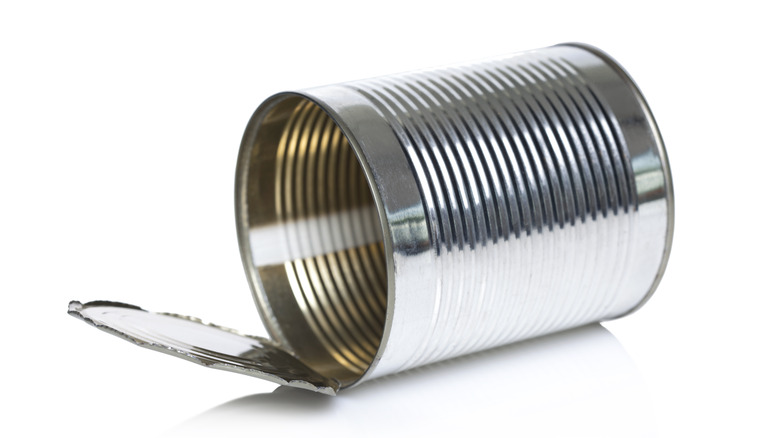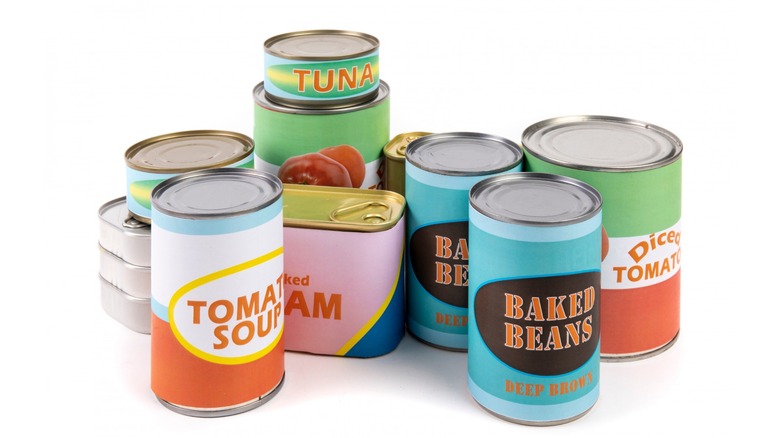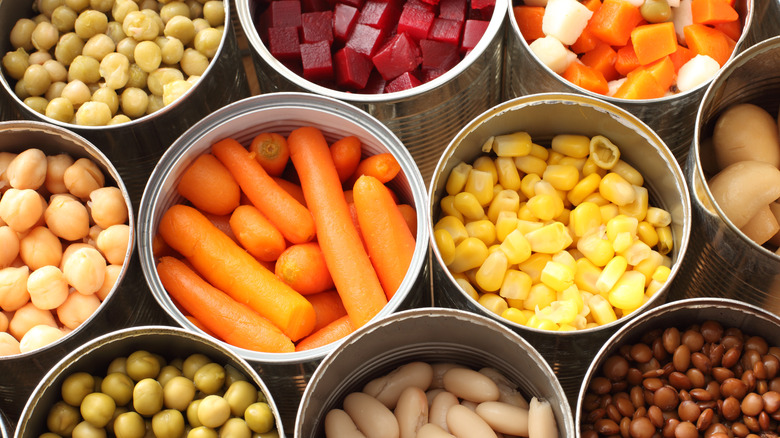What's With The Ribbed Marks On Canned Goods?
Almost every pantry contains a few things: an expired (and open) box of Saltines, last year's Christmas popcorn tin (go ahead and toss it), and a shiny, silvery army of canned goods in various shapes and sizes. From tinned fish to corn, beans, and even cranberry sauce, canned foods are a staple in most Americans' food supply. But you've probably wondered about the various shapes of those perfectly preserved goods. One of the most popular can shapes comes with a pretty odd feature: ridges that cover the middle portion of the can. The can's label usually covers these ridges and is often featured on cans of sauce, vegetables, cranberry sauce, and beans among other products.
But why are those little ridges there? Believe it or not, those ridges do more than add flare to canned cranberry sauce. They have a very practical purpose. Mainly, the ribbed edges on your can help make your cans stronger. The ribs, which curve around the can's center, help to prevent dents in the cans, which can be potentially dangerous. But that's not all, the ridges also help during the canning process, as they allow the container to expand and contract during the canning process. Of course, not all cans require ridges. Dried goods or less perishable cans do not require ribbing, however, those ribs serve a vital purpose in keeping your food at its freshest.
A can goes a long way
Those ridges on your can serve a vital purpose when it comes to canning foods, helping to stop containers from rupturing when heated for sterilization purposes during the canning process. However, those ridges also help protect your food after the canning process as well. Those ribs that help prevent cans from rupturing or losing their structural integrity during canning also help to protect cans as they make their way to the grocery store, and your pantry. This is because the ribs around cans help make cans more structurally sound, and less likely to expand or dent, thus preventing food waste from defective containers.
However, dents on cans are more than just an issue of aesthetics. Dents and ruptures on canned goods can be a hazard to your health. Yes, though canned goods are largely safe to consume, and have proven to be an essential tool in food preservation, they are also susceptible to certain safety issues if ruptured or severely dented. One of the biggest risks with damaged cans is botulism. Though rare, C. botulinum bacteria can be found in improperly canned goods. Botulism can cause serious and life-threatening illness, so it's important to know the signs of an improperly canned, or damaged canned good. Additionally, it is important to note the risks of canning goods at home, as home canning can be potentially risky.
Inspecting your cans
Now it's important to reiterate that the risk of botulism, or other contaminations in mass-produced canned goods is rare. However, it is important to be aware of certain signs that your canned goods might not be safe for consumption. This doesn't mean that you have to toss every can that has a slight dent on its side. However, there are a few key signs that your canned food has been damaged and should be tossed.
Minor dents that don't fall on a seam and don't contain sharp edges, for example, are usually safe. However, if your dent falls on the side seam of your can, or has sharp edges, this is an indication that your canned food has been compromised and should be tossed. Additionally, if two dents meet at a point, forming a sharp crease, the food in the container is most likely no longer safe for consumption. This is the same for crushed cans, or for cans that have a crease in the top seam. However, if the crease is located on the bottom of a can that doesn't have a bottom seam, the dent is most likely minor.
But perhaps the biggest red flag to look out for when inspecting your cans is bloating. If your can is swollen, this is a clear indication that you should toss your can. This is just general guidance, however, if you are concerned about the safety of a food item you can visit the U.S. Department of Agriculture website.


